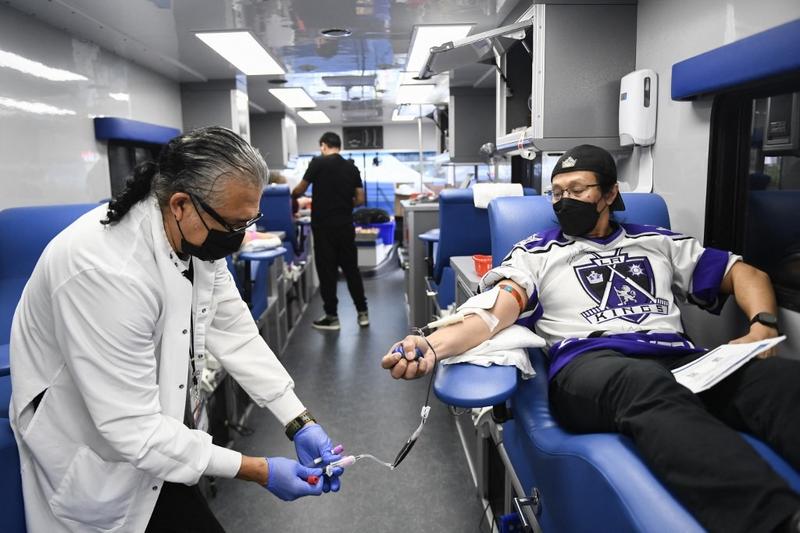 A person donates blood during a Children's Hospital Los Angeles blood donation drive in the LA Kings blood mobile outside the Crypto.com Arena on Jan 13, 2022 in Los Angeles, California. (Patrick T. FALLON / AFP)
A person donates blood during a Children's Hospital Los Angeles blood donation drive in the LA Kings blood mobile outside the Crypto.com Arena on Jan 13, 2022 in Los Angeles, California. (Patrick T. FALLON / AFP)
Blood supply reserved for medical use is so low in the United States that the first sentence on the homepage of the American Red Cross is: "WARNING: BLOOD CRISIS" in bold.
The Red Cross, which contributes to 40 percent of the nation's blood supply, said it is the "worst blood shortage" in more than a decade and has had to limit blood product distributions to hospitals as a result.
Blood donations have declined by 10 percent since March 2020, according to the Red Cross College. High school students who accounted for a quarter of total blood donations in 2019 had the steepest drop-62 percent.
The bad winter weather and surge in Omicron cases have further driven down the blood supply. People have also canceled donation appointments because they are infected with the coronavirus and cannot donate blood.
Through the end of January in North Carolina, about 75 percent of donation appointments were unfilled compared to 56 percent a year earlier. In addition, blood drives hosted by employers and colleges have been frequently canceled throughout the pandemic because of closures or work-from-home policies.
There is also a staffing shortage as a result of the pandemic. Medical staff members have to quarantine when they test positive for the coronavirus. But some people said they have a hard time scheduling a donation now because the slots are full until March. This has been further complicated by supply chain pressure on needles, bags and other equipment.
In a Feb 8 report by America's Blood Centers, 16 of 59 blood centers across the nation have a one-day supply of blood and 18 centers have one to two days of blood supply.
Only one center reported blood for three days or more, while the rest supplied no data. That means at least more than half of the blood centers have one to two days of blood supply or less.
January is traditionally a blood donation drive period for the Red Cross. The organization appealed to the public for blood donations by sharing the story of Kristen Mill from Spring Grove, Illinois.
Hard time
Mill's body cannot produce enough hemoglobin to carry oxygen in her blood, a health problem caused by a tick bite in 2008. Weekly blood transfusions are essential for her to survive.
On a recent visit to the hospital for a transfusion, she was told the hospital had no blood that matched her type, and she would have to wait until the right match became available.
"It's very scary, especially if you don't know if the blood is coming, because this is something that you need to live," said Mill, who ended up having to wait for blood on multiple occasions in recent weeks.
Mill is worried that the next time she needs blood, it may not arrive in time to keep her alive. After seeing firsthand what a blood shortage means, she has become an advocate for blood donations.
Some hospitals have had to postpone surgeries because they did not have enough blood to cover any emergencies that might come up the same day, Nancy Foster, a vice-president with the American Hospital Association, told The Associated Press.
Blood shortages can cost lives. When car accidents or natural disasters strike, it can result in a situation that a lot of blood is needed to save people.
"If we have a hurricane or tornado and God forbid a lot of people get injured and need major surgery for broken bones, we could be in trouble," Marisa Marques, medical director of transfusion services at the University of Alabama at Birmingham Hospital, told The Wall Street Journal.
Agencies contributed to this story.



